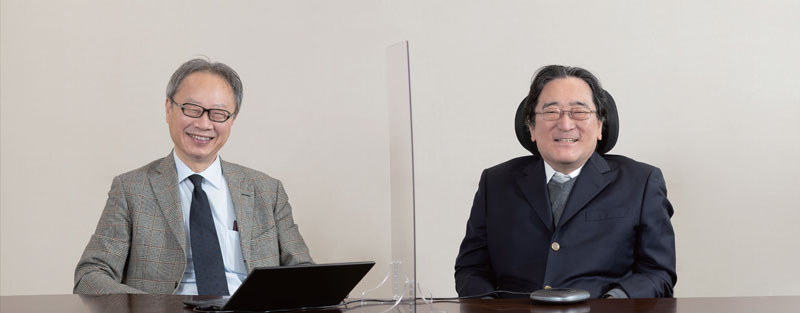
20 years of RISTEX
Dialogue #3
KOBAYASHI Shinichi X KOBAYASHI Tadashi
KOBAYASHI Shinichi, who has long been committed to the research and practice of S&T policy, was also a key person in establishing RISTEX (System), the predecessor of current RISTEX. He introduced to relevant officers and institutions the theories that founded the concept of S&T for Society (STfS) and conducted surveys to further the consideration. Moreover, he set up the S&T for Society Research Forum, which was designed to function as a sustainable cycle of knowledge that allowed knowledge and experiences of STfS to be accumulated and applied further. Although the Forum was discontinued after the organizational reform, a need for such a mechanism is increasingly more apparent today. In this dialogue, such functions of the Forum in securing the future of STfS was scrutinized.
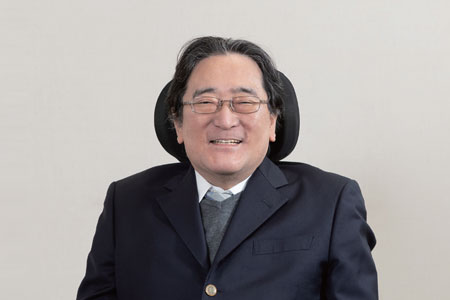
KOBAYASHI Shinichi
KOBAYASHI Shinichi served as the Director of Research at the National Institute of Science and Technology and Policy, a Professor at the University of Tsukuba, the Director at Center for Technology and Social Research, the National Institute of Advanced Industrial Science and Technology, and a Senior Specialist at the National Diet Library. Currently, he is the Director of the Research Institute for Higher Education and the Dean of the Graduate School of Humanities and Social Sciences at Hiroshima University. Major publications include: Wen and Kobayashi "Exploring collaborative R&D network" Research Policy, 2001; "Savages in a Civilized Society" in R&D Strategies in Japan (Etoh ed.), 1993; and "Technology Assessment Activity at the National Diet Library of Japan" in "Technology Assessment in Japan and Europe" (Moniz and Okuwada eds.) 2016.
He is known for the Japanese translation of The New Production of Knowledge: The Dynamics of Science and Research in Contemporary Societies by Michael Gibbons et al.
The Aim of the Forum: a Mechanism to Sustain STfS
KOBAYASHI Tadashi (KT): It's been 20 years since the birth of current RISTEX's predecessor, RISTEX (System). Then there was a ministerial reform and in the newly established the Ministry of Education, Culture, Sports, Science and Technology (MEXT), after the merging of the Science and Technology Agency and the Ministry of Education, Science Sports and Culture, there was a discussion about what roles the ex-S&T Agency should play.
KOBAYASHI Shinichi (KS): Yes. So I sought for ideas from researchers in various disciplines, and obtained a list of research topics. These I think became the original candidates of research topics that RISTEX was to engage. But we struggled to attain an umbrella concept that described the essence of these topics. After much consideration, 公共技術 (public technology) was suggested but it had a nuance of civil engineering, so we continued to seek the right expression and finally arrived at 社会技術.
KT: Which is equated as 'S&T for Society' in English. This is a part of the phrase, "science in society, science for society" of the Budapest Declaration.
KS: Yes. In fact, I was the one who decided to use S&T for Society, and then I wanted to incorporate both 'in' and 'for.' RISTEX (System) was established by the joint effort between JAERI*1 and JST. I think the series of nuclear power related incidents then influenced on the decision. As S&T 'in society' was just beginning to gain certain recognition then, I didn't think many people were yet convinced by the idea, so I adopted S&T 'for society' alone.
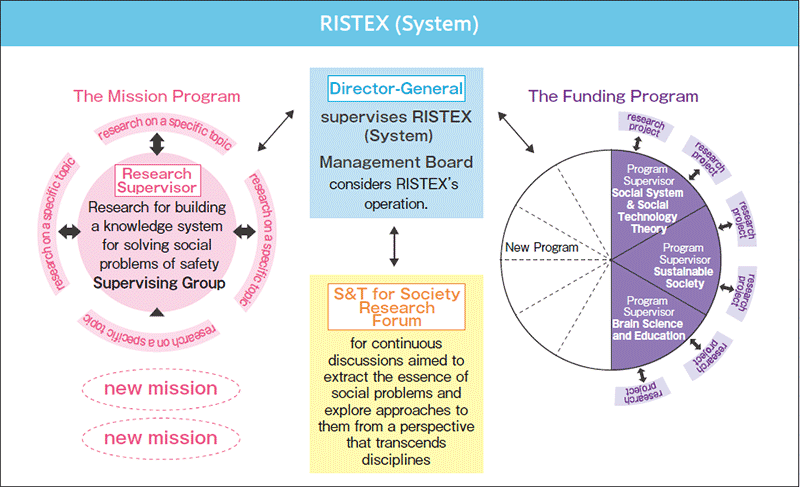
KT: What was your position then?
KS: I was in charge of practical matters as the Vice Chairperson of the S&T for Society Research Forum (Forum), which was a section of RISTEX (System).
KT: We can still access online JST's announcement about the establishment of RISTEX (System) on July 18, 2001.*2 It says that JAERI and JST jointly promote research by establishing RISTEX (System) as a practical institution to promote technologies for build new social systems by integrating multiple disciplines from natural sciences, social sciences and humanities (i.e., STfS). Further, it describes the structure of practice as consisting of 3 programs: (1) Mission Programs (by JAERI), (2) Funding Programs (by JST), and (3) S&T for Society Research Forum (by JAERI and JST). You were in charge of the (3), the Forum which was to extract the fundamental problems underlining social issues and to discuss continuously how to deal with such problems by the conduct of issue-driven research.
KS: Within RISTEX my role was the management of the Forum, but I was involved in RISTEX from its establishment, and was engaged in designing its programs and functions. Based on such experiences, I think the Mission Programs had certain difficulties in collaborating with RISTEX (System) itself and also with surrounding organizations because it was allocated a large budget from JAERI and thus became like an independent organization within an organization. As for the funding program, there was no established format yet. So the Forum was to coordinate the two programs. The funding program of RISTEX (System) was unusual in many ways compared to conventional programs. This is due to the experience of experimental efforts at the Takeda Foundation which was established in 2001. They started funding research on advanced S&T and society from the perspectives of people living in society, and I was involved in trying out various approaches to the project selection procedure. For example, we set up a session in which research proposers needed to discuss with each other, for them to remain candidates. We tried novel approaches as the most important thing in promoting good research is setting good research topics and building a good organizational structure with a good combination of people. That call was international, so the discussion was actually conducted online and in English. Candidates were apprehensive at first, but once it took place, they understood why it was important and thus the procedure received good feedback.*3
KT: That sounds interesting. What was behind such a novel selection procedure?
KS: In the 1990s, the Swiss National Science Foundation (SNSF) had already started transdisciplinary pursuits such as public participation and open discussions especially about environmental issues. When I saw that, I realized that we were already in need of different approaches to conventional basic research.
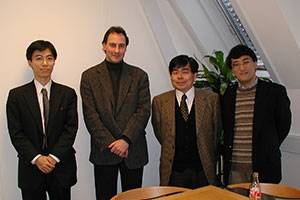
The Danish Board of Technology, 2002
KT: That way of thinking sounds like a typical 'Mode 2' approach, of the theory of knowledge production modes, which argues that there are two types of relationship between S&T and society. In Mode 2, knowledge is not produced within the established framework of given academic disciplines, but starts with the recognition of specific problems and incorporates various knowledges to solve these. For that, new knowledge may be willingly produced, and that can transcend the existing disciplinary boundaries. You were experimenting a new approach to the conduct of research.
KS: Yes. While studying the transdisciplinary activities that were developing in Europe, I was wondering what could be done in Japan. And we took actions whenever we could, such as including the stakeholder participation in the proposal requirement. Since the Mode 2 knowledge production starts from defining the problem which is not done solely by researchers, the crucial part is in initiating a co-design/co-creation process. With that in our mind, we attempted various approaches. Other than that, I was involved in designing the research retreats for the Mission Program. As Mission Program research was conducted without setting a clear goal, we organized the retreat so that researchers could discuss the directions of their research.
KT: The culture of retreats is still a core characteristic of R&D in RISTEX, although these are currently conducted largely online due to the spread of COVID-19.
KS: Talking about the characteristics of RISTEX, I gave a speech in a Forum session about 'demonstration and implementation' based on the discussion in Europe. Unlike basic research, STfS is expected to be conducted with clear outputs. But the actual implementation needs to rely on NPOs and corporates. So, based on what these terms signified in the European discussion then, I translated demonstration as 試行of which literal meaning is experimental trials, and implementation as 活用, literally, utilization or application, because there was yet a fair degree of reluctance toward implementation per se. Retrospectively, I think my role was in the articulation of these notions, that what could be done within the framework of research is demonstration, and application which is prior to the actual implementation. I would also emphasize that social implementation is an idea that can only come from mode 2, as the classic linear model of innovation is progressive and assumes diffusion spontaneous.
KT: Now we hear social implementation emphasized in many places, but at RISTEX, we still regard R&D as conducting not the implementation itself but one step before it. Besides, the Mission Program and the funding programs directly promoted research, but the Forum was somewhat different in its nature as I understand it.
KS: I chose the term 'forum' to signify a place where anyone interested could gather and deliberate - people who are interested, and members of completed projects could gather, and share the network and knowledges accumulated.
When RISTEX (System) was about to start, I had frequent meetings with the director in charge at the MEXT. There, we realized that a mechanism to facilitate the continuous R&D in STfS was needed, and we considered setting up a unit like an independent lab, which looked across projects and identified what would become necessary next. This idea was further elaborated and we decided to add a function as an open 'forum' in which various opinions could be expressed. We wanted to build a mechanism to involve people who engaged in important activities, in order to share and accumulate academic knowledge as well as the practice of identifying potential research topics, researchers, and methodology, as that could be the engine for driving STfS. Otherwise, methods and networks of people cannot be used widely by others and become wasteful. New research topics were bound to emerge if people with the experience of STfS gathered and discussed, but perhaps it was too bold an approach at the time. Then the initial projects had just started, and the mechanism which was designed to function after the completion of projects could not be realized, which was unfortunate.
*1 Japan Atomic Energy Research Institute
*2 http://www.jst.go.jp/pr/announce/20010718/sankou.html
*3 Kazuyoshi Shimada, Mitsuo Akagi, Tohru Kazamaki and Shinichi Kobayashi "Designing a proposal review process to facilitate interdisciplinary research" Research Evaluation, 16:1, 2007.
The Importance of Researchers and People in Society to Think Together in a Transdisciplinary Manner
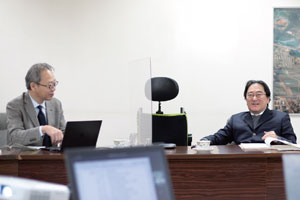
KS: The term 'transdisciplinary' is still translated as 超学際, literally 'super-interdisciplinary.' This often gives a wrong impression that it is a superior version of interdisciplinary research, which causes a problem of not positioning stakeholders rightly as equal partners, and thus, mistakenly regarding social aspects too lightly and assuming researchers as benevolent figures who do research for people. To avoid that, Europeans today describe transdisciplinary research as 'interdisciplinary research plus co-creation with society.'
KT: And in Japan, co-creation with society tends to be equated with the academic-industrial alliance. 総合知 sogo-chi (translated as convergence of knowledge, but literally, comprehensive knowledge) should also have the connotation of transdisciplinarity, but some arguments assume its implication very narrowly to merely mean a tool for innovation. In that sense, R&D with stakeholders that RISTEX has been promoting is truly transdisciplinary in its nature.
KS: I agree, and I think RISTEX was very aware of that especially in early times. For example, the project for tsunami evacuation lead by KATADA Toshitaka, and the project for simulating infectious diseases led by NISHIURA Hiroshi (for both projects, see the Timeline) had significant social impacts. The fact that RISTEX has provided research opportunities to such projects implies how cost-effective RISTEX is even among other JST programs. Then, I think it is important to make what have been achieved in RISTEX visible. In other words, a core unit or entity that functions as a living archive is needed, so that any inquiry about the past achievements can be easily referred to. Just having a list of projects is not very meaningful. All the more reasons why we should always be able to grasp the accumulation of STfS.
Speaking of 総合知, recently I have been concerned about the way the politics and the government decide the direction of S&T, which began to be observable since the Thatcher administration in the UK, and I have argued that in a paper.*4 Historically, in Japan, the only instance politicians interfered in research and education was in the prewar army, but lately there has been a tendency for politics to judge what is good for research and education.
KT: Today's authorities around the world are increasingly more interested in controlling the direction of research so that more social impact can be generated efficiently.
KS: 総合知, if driven in a wrong direction, could become detrimental to R&D. But the reality is, we can no longer generate innovation or develop solutions to social issues such as poverty, or more generally, disparity, without transdisciplinarity – we need to incorporate what we can gather.
KT: Hence poverty, or disparity, can be a potential research topic in RISTEX, but if we were to set up a corresponding funding program, coordination is required between us and the MEXT which has jurisdiction over JST, as well as the Ministry of Health, Labour and Welfare and the Ministry of Economy, Trade and Industry. Then, we really do have to take into consideration the influence of politics and determine how much freedom we have. Around 2016, I attended a meeting for presidents of universities in Europe and Japan. There I heard one British president saying that society was becoming less generous to universities. Universities used to be respected, but nowadays people ask what they can do for them. That was striking as the same could be said in Japan, too. With such a social change, what do you think should RISTEX, as a funding agency that has been promoting transdisciplinary research for 20 years, be aware of in future? And how do you think should universities change in future?
KS: There are merits to government officers and politicians deciding research topics but ultimately, researchers and people in society need to think together to identify what the truly fundamental problems are. In fact, there already existed an argument in the 1970s about the need for a platform where people with various interests could gather and discuss when deciding important research topics. There was a question about research structure, that is, whether to conduct research in projects or in organizations. Project-based research is promoted by JST and Japan Society for the Promotion of Science (JSPS), but Japan is lacking a platform for organization-based research. As a result of the weight on competitive research fund, much of the research has become project-based. This is of course important, but we are yet to achieve a mechanism of organizational research which can continuously engage in discussions across various disciplines, prior to identification of individual research topics. Issue-driven research is important, but discovering problems is the most essential. Current S&T policy is running without that mechanism. What I hoped for was such a function to be equipped in RISTEX.
KT: After the Great East Japan Earthquake, I had an opportunity to discuss with bureaucrats and NPOs, and I asked them what they expected from experts. To that, everyone answered that they wanted experts to think along with them. They wanted experts not to instruct them, but to think together with them.
KS: Universities must understand that. And although current strategies look to achieve more outputs efficiently in short periods of time, they should know that Japanese S&T is actually not bad in terms of the stock of research resources and outputs. But these days, research areas are disappearing. Although there still are many studies that are considered rather important worldwide, not much is passed on. It is important to make good use of their legacy, also it would be accordant with the concept of SDGs.
KT: Researchers tend to be interested in being the front runners in their research fields, but development targeting surviving markets are in fact valuable. Also, RISTEX normally calls for research proposals for 3 years, and funds individual projects typically for 3 years. However, for issues such as the aging society continues long after the program is ended. Thus, without a mechanism to preserve knowledges accumulated, we may need to repeat starting from scratch, which is my concern.
KS: In that sense, my biggest regret is that we could not realize such a function. It would be great if we could create such a system.
KT: Today I have realized once again that the mechanism for the continued pursuit of STfS, which was lost in the past is increasingly more necessary now. Thank you very much for a very important input.
*4 Shinichi Kobayashi and Eriko Fukumoto "The Endless Overcontrol and Overadaptation: Consequences of National University Reform in Japan" Hitotsubashi Business Review, 69:2, 2021.
(Hiroshima, December 27, 2021)
| 20 Years of RISTEX / S&T for Society TOP >>> | 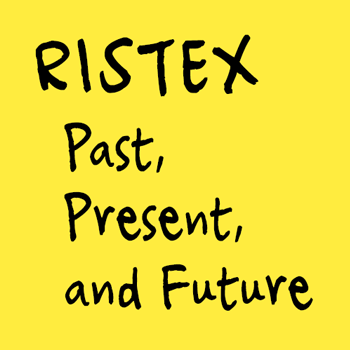 |